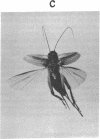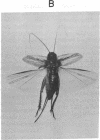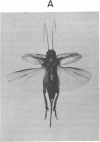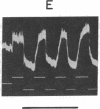Abstract
We investigated the steering responses of tethered, flying adult female crickets (Teleogryllus oceanicus) to acoustic stimulation. Crickets responded directionally to directional sound stimulation by bending their abdomens and hind legs to one side. We interpret this response as an attempt to turn. When stimulated with a model of conspecific calling song with a carrier frequency of from 3 to 9 kHz, crickets turned toward the sound source. We believe that this indicates a positive phonotactic response of flying females to calling, conspecific males. When offered a choice between conspecific song and the song of another species, females turned exclusively toward conspecific song, demonstrating that the response is species specific. The direction of the response is dependent on the carrier frequency of the song, and it demonstrates frequency discrimination. Females turned toward calling song when it was played at carrier frequencies from 3 to 9 kHz, but they turned away from the same song pattern played at carrier frequencies from 30 to 70 kHz. This negative phonotaxis to ultrasonic stimuli suggests that crickets, like some other nocturnal flying insects, can evade bats by acoustic detection.
Keywords: phonotaxis, acoustic communication, neuroethology, frequency discrimination, insect hearing
Full text
PDF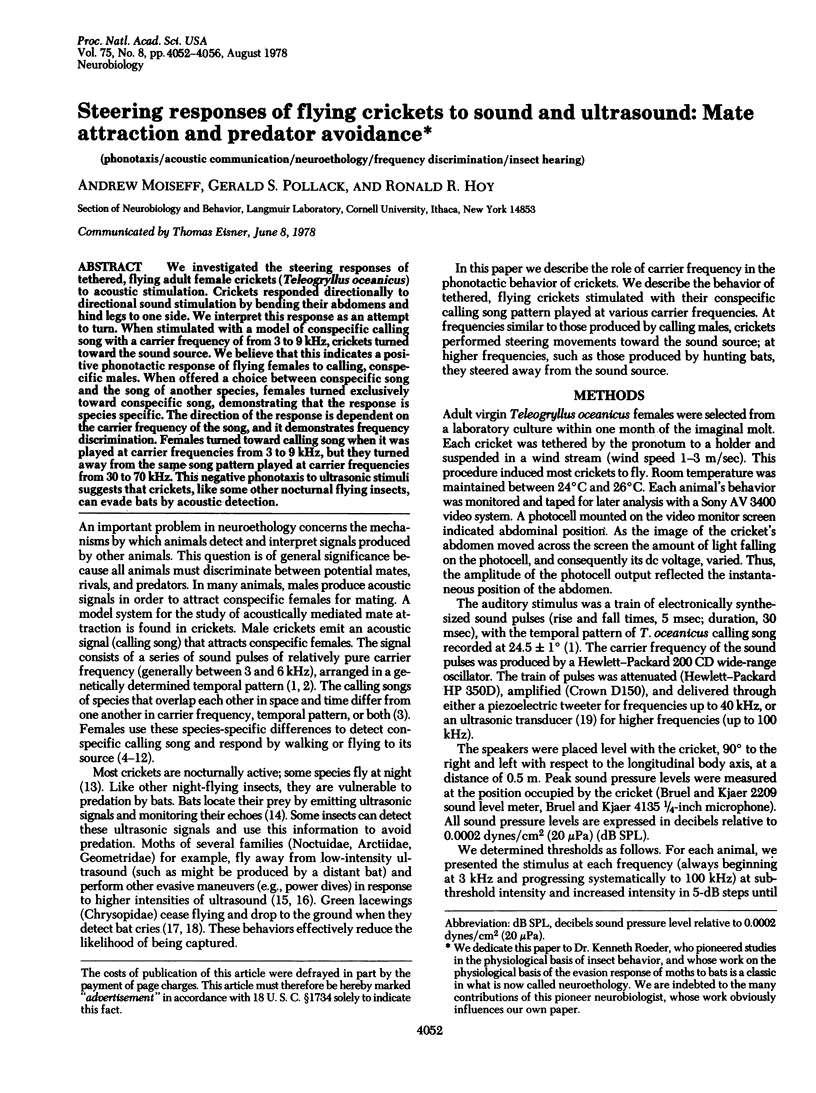
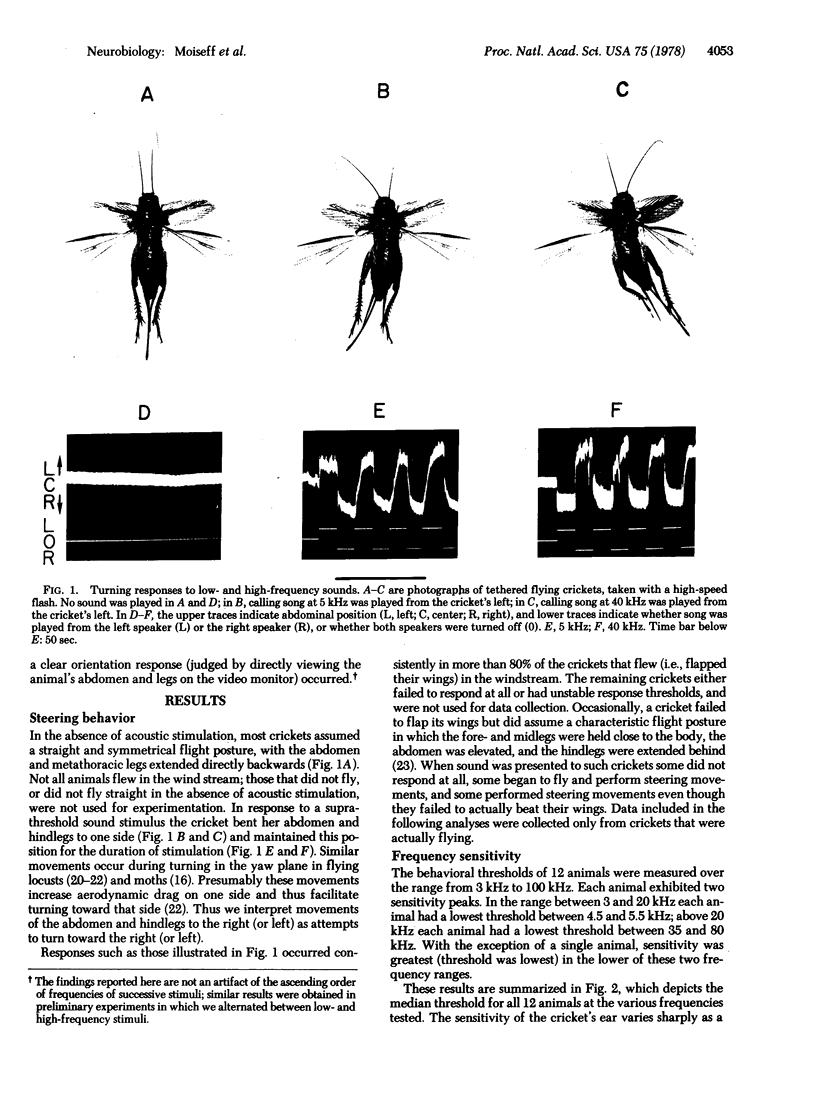
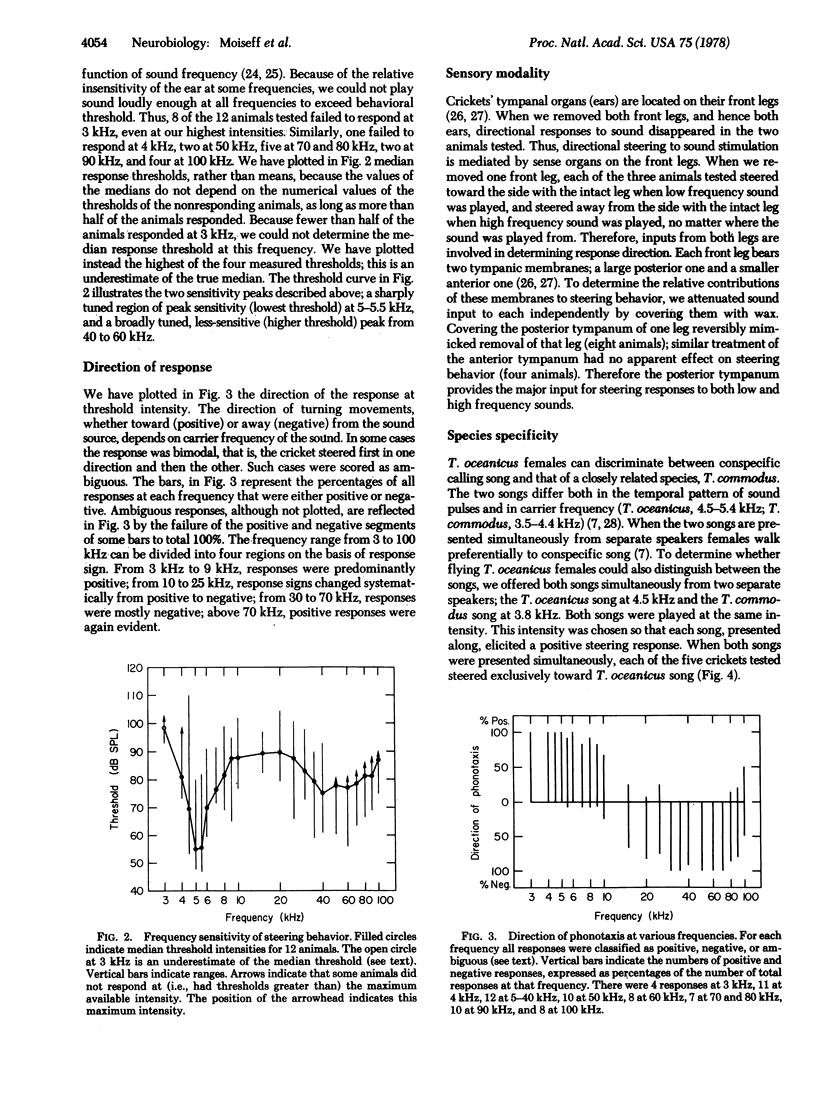
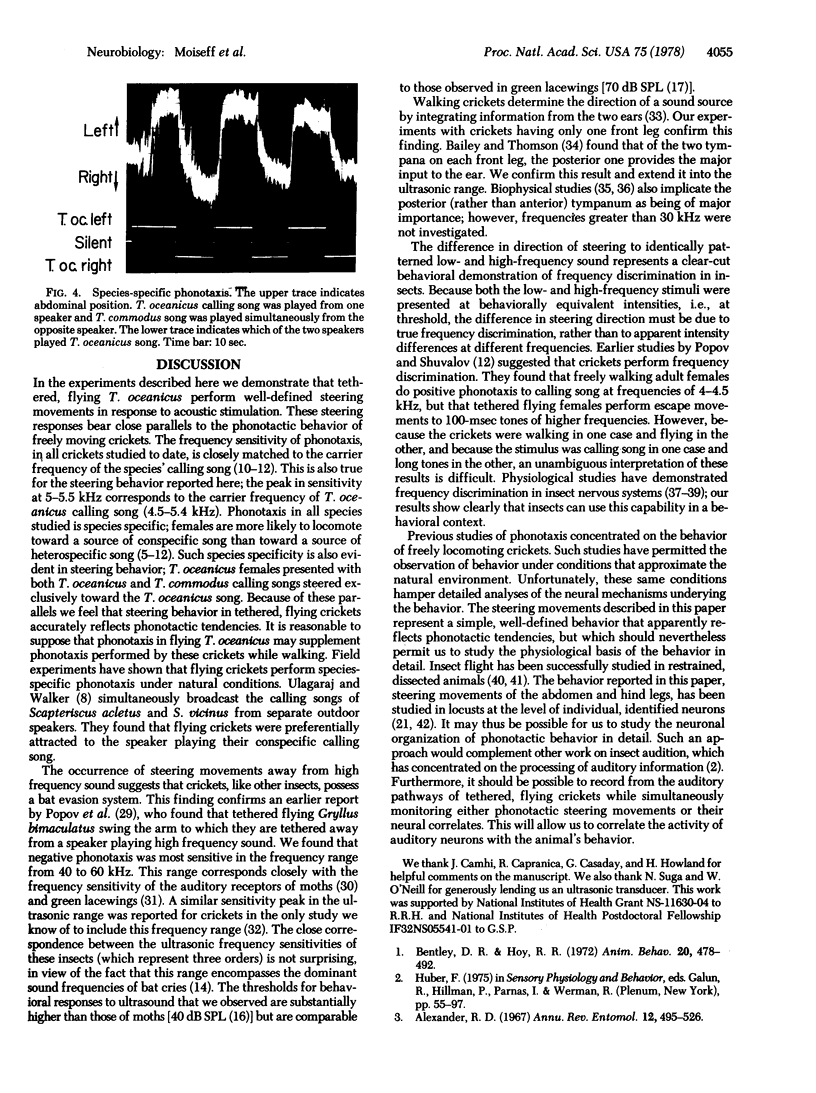
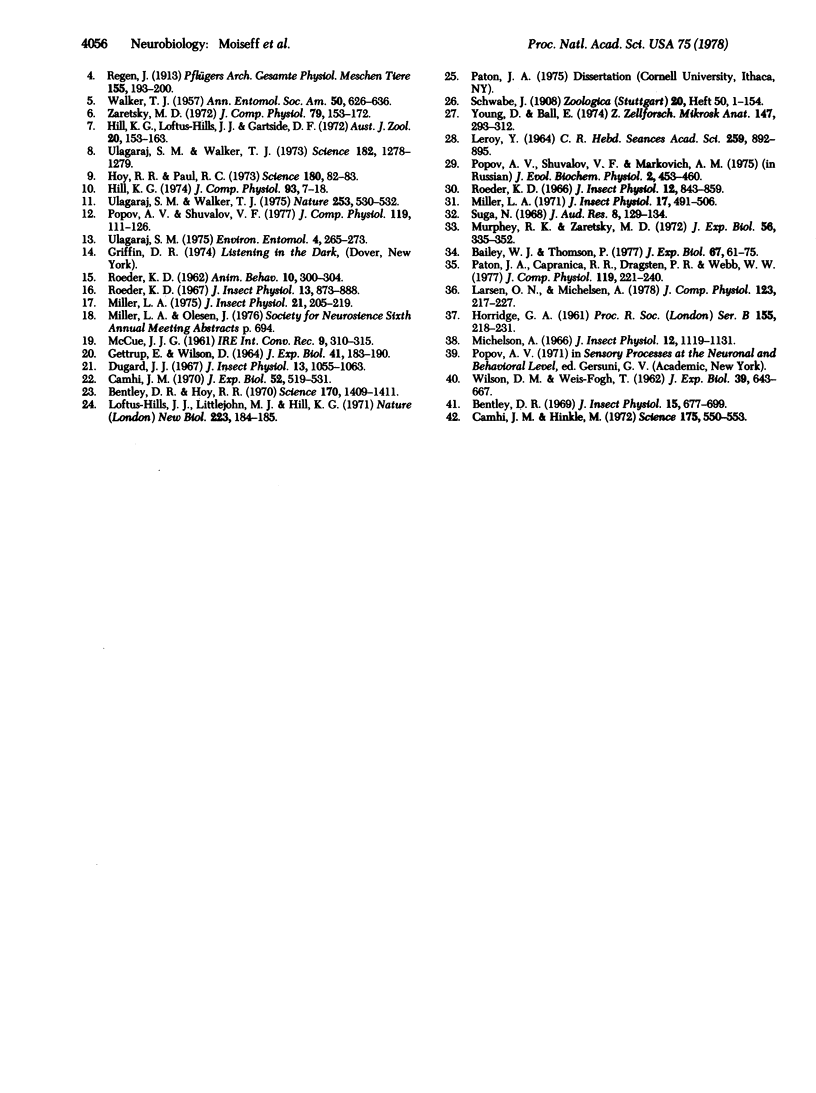
Images in this article
Selected References
These references are in PubMed. This may not be the complete list of references from this article.
- Bentley D. R., Hoy R. R. Genetic control of the neuronal network generating cricket (Teleogryllus Gryllus) song patterns. Anim Behav. 1972 Aug;20(3):478–492. doi: 10.1016/s0003-3472(72)80012-5. [DOI] [PubMed] [Google Scholar]
- Bentley D. R., Hoy R. R. Postembryonic development of adult motor patterns in crickets: a neural analysis. Science. 1970 Dec 25;170(3965):1409–1411. doi: 10.1126/science.170.3965.1409. [DOI] [PubMed] [Google Scholar]
- Bentley D. R. Intracellular activity in cricket neurons during the generation of behaviour patterns. J Insect Physiol. 1969 Apr;15(4):677–699. doi: 10.1016/0022-1910(69)90264-9. [DOI] [PubMed] [Google Scholar]
- Camhi J. M., Hinkle M. Attentiveness to sensory stimuli: central control in locusts. Science. 1972 Feb 4;175(4021):550–552. doi: 10.1126/science.175.4021.550. [DOI] [PubMed] [Google Scholar]
- GETTRUP E., WILSON D. M. THE LIFT-CONTROL REACTION OF FLYING LOCUSTS. J Exp Biol. 1964 Mar;41:183–190. doi: 10.1242/jeb.41.1.183. [DOI] [PubMed] [Google Scholar]
- Hoy R. R., Paul R. C. Genetic control of song specificity in crickets. Science. 1973 Apr 6;180(4081):82–83. doi: 10.1126/science.180.4081.82. [DOI] [PubMed] [Google Scholar]
- LEROY Y. TRANSMISSION DU PARAM'ETRE FR'EQUENCE DANS LE SIGNAL ACOUSTIQUES DES HYBRIDES F1, ET PXF1, DE DEUX GRILLONS: TELEOGRYLLUS COMMODUS WALKER ET T. OCEANICUS LE GUILLOU (ORTHOPT'ERES, ENSIF'ERES) C R Hebd Seances Acad Sci. 1964 Jul 27;259:892–895. [PubMed] [Google Scholar]
- Loftus-Hills J. J., Littlejohn M. J., Hill K. G. Auditory sensitivity of the crickets Teleogryllus commodus and T. oceanicus. Nat New Biol. 1971 Oct 6;233(40):184–185. doi: 10.1038/newbio233184a0. [DOI] [PubMed] [Google Scholar]
- Michelsen A. Pitch discrimination in the locust ear: observations on single sense cells. J Insect Physiol. 1966 Sep;12(9):1119–1131. doi: 10.1016/0022-1910(66)90127-2. [DOI] [PubMed] [Google Scholar]
- Murphey R. K., Zaretsky M. D. Orientation to calling song by female crickets, Scapsipedus marginatus (Gryllidae). J Exp Biol. 1972 Apr;56(2):335–352. doi: 10.1242/jeb.56.2.335. [DOI] [PubMed] [Google Scholar]
- Popov A. V., Shuvalov V. F., Markovich A. M. Spektr prizuvnukh signalov, fonotaksis i slukhovaia sistema sverchkov Gryllus bimaculatus. Zh Evol Biokhim Fiziol. 1975 Sep-Oct;11(5):453–460. [PubMed] [Google Scholar]
- Roeder K. D. Acoustic sensitivity of the noctuid tympanic organ and its range for the cries of bats. J Insect Physiol. 1966 Jul;12(7):843–859. doi: 10.1016/0022-1910(66)90035-7. [DOI] [PubMed] [Google Scholar]
- Ulagaraj S. M., Walker T. J. Phonotaxis of crickets in flight: attraction of male and female crickets to male calling songs. Science. 1973 Dec 21;182(4118):1278–1279. doi: 10.1126/science.182.4118.1278. [DOI] [PubMed] [Google Scholar]
- Young D., Ball E. Structure and development of the auditory system in the prothoracic leg of the cricket Teleogryllus commodus (Walker); I. Adult structure. Z Zellforsch Mikrosk Anat. 1974 Mar 11;147(3):293–312. doi: 10.1007/BF00307466. [DOI] [PubMed] [Google Scholar]



